Workplace Harassment and Violence Prevention Regulations – What We Heard
On this page
- Introduction
- About this report
- Demographics
- Timelines
- Training
- Competent person
- Support
- Policies and reporting
- Family violence
Introduction
Over the past nine months the Labour Program has been engaging Canadians regarding the new harassment and violence regulations that will support the coming into force of Bill C-65, An Act to amend the Canada Labour Code (harassment and violence), the Parliamentary Employment and Staff Relations Act (PESRA) and the Budget Implementation Act, 2017, No. 1 (the Act). Consultations were undertaken in three phases.
The initial phase of the consultations included round tables convened across the country with federally regulated employers, employee representatives, subject matter experts and organizations supporting those populations known to experience higher incidents of harassment and violence. Phase one helped to: clarify the qualifications of individuals undertaking workplace harassment and violence investigations; highlight the essential elements of an investigation report; make apparent that discipline is the employer’s domain so the investigator should not make recommendations regarding discipline; and inform the timelines for the resolution process.
Phase two was a series of WebEx meetings that targeted sectors not represented at the round tables and served as an opportunity for those who attended the round tables to appreciate how their input contributed to the revisions of the proposed harassment and violence regulations. Key input from the WebExs included: the recommendation to qualify the terms ‘mediators’ and ‘mediation’ to broader language so that Elders and spiritual leaders could see themselves in the redefined terms and be considered as mediators; advice on timelines for the resolution process; and clarification on the concept of co-development.
The final and third phase of the consultation was online, with Canadians having the opportunity to review the Labour Program’s consultation paper titled Proposed Regulatory Framework: Harassment and Violence and complete a related survey and/or submit written responses.
The results of all three phases of the consultations inform the drafting of the harassment and violence prevention regulations.
The Labour Program greatly appreciates all the feedback received throughout the consultation process.
About this report
The Workplace Harassment and Violence Prevention Regulations – What We Heard report provides the highlights of the online survey completed by 1018 respondents. The responses, as outlined below, have been grouped into seven themes.
Demographics
Who responded to the survey?
The majority of respondents who completed the survey were individuals (Figure 1), of which approximately 50% work in a federally regulated industry (Figure 2). Respondents were from all across Canada, with most responses coming from the four largest provinces (Figure 3).
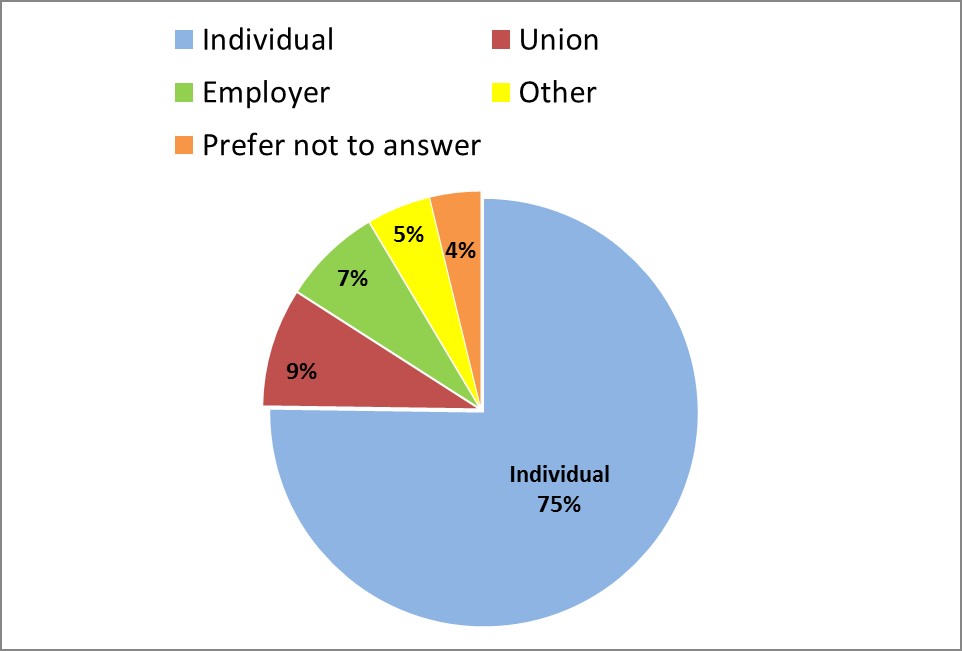
Text description
| Response | Number | % |
|---|---|---|
| Individual | 774 | 75% |
| Union | 91 | 9% |
| Employer | 76 | 7% |
| Other | 49 | 5% |
| Prefer not to answer | 39 | 4% |
| Grand total | 1029 | 100% |
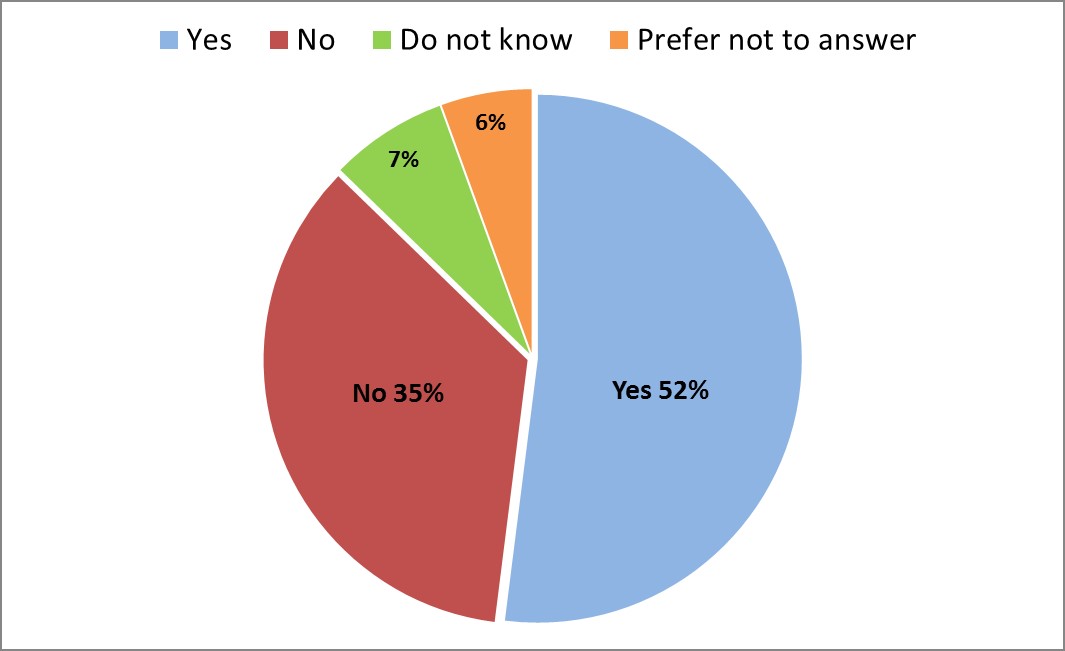
Text description
| Response | Number of respondents | % |
|---|---|---|
| Yes | 535 | 52% |
| No | 363 | 35% |
| Do not know | 74 | 7% |
| Prefer not to answer | 57 | 6% |
| Total | 1029 | 100% |
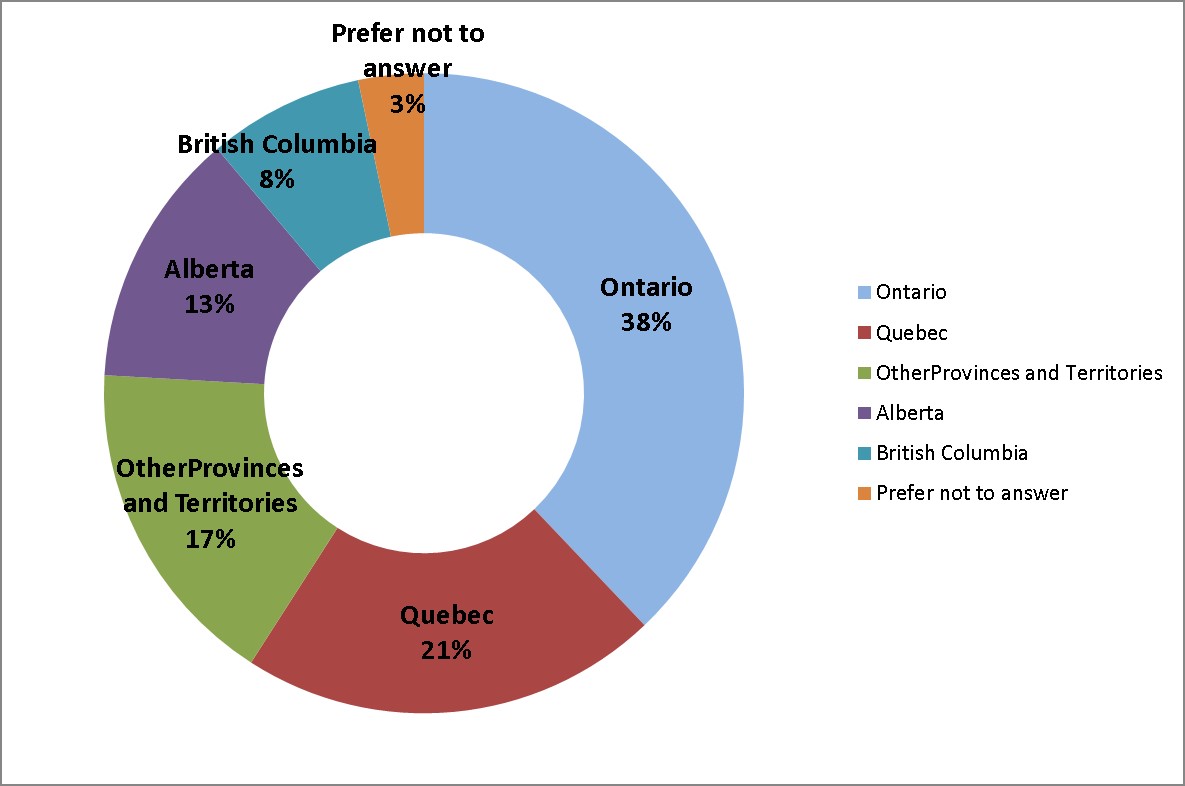
Text description
| Response | Number of respondents | % |
|---|---|---|
| Ontario | 390 | 38% |
| Quebec | 218 | 21% |
| Other Provinces and Territories | 173 | 17% |
| Alberta | 133 | 13% |
| British Columbia | 81 | 8% |
| Prefer not to answer | 34 | 3% |
| Grand Total | 1029 | 100% |
Timelines
To ensure that federally regulated employers adequately respond to complaints of workplace harassment and violence, the amended regulations will set specific timeframes for the resolution process. We asked about timelines of various parts of the resolution process.
This is what you told us:
86% of respondents agreed with the statement: Employers will be required to acknowledge receipt of a notification of harassment and violence that occurred in their workplace as soon as possible, but no later than five calendar days.
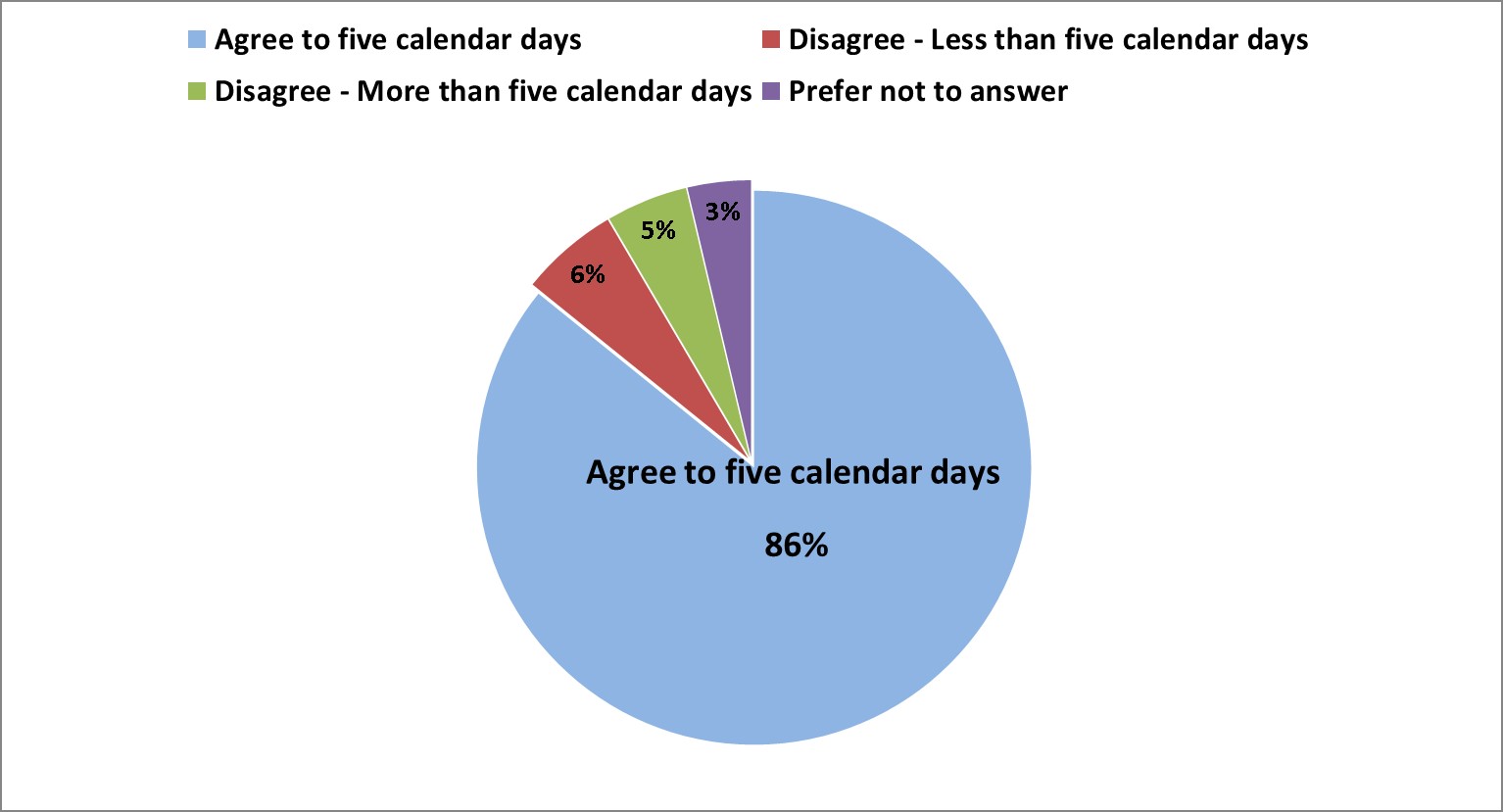
Text description
| Response | Number of respondents |
|---|---|
| Agree to five calendar days | 883 |
| Disagree - Less than five calendar days | 59 |
| Disagree - More than five calendar days | 49 |
| Prefer not to answer | 38 |
| Grand Total | 1029 |
85% agree with the statement: “the employer will be obligated to provide monthly updates on the status of the resolution process to the complainant and the respondent.”
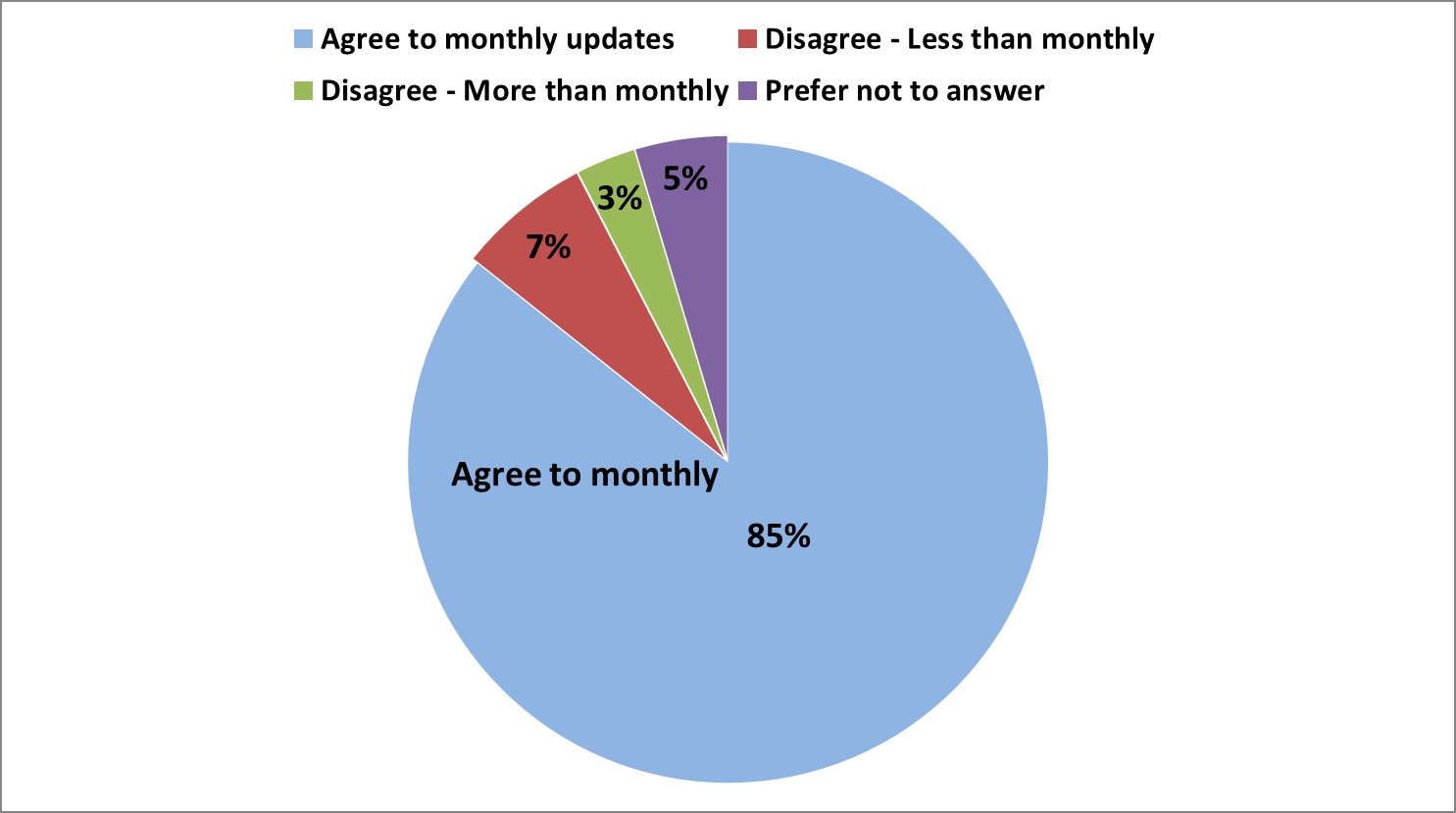
Text description
| Response | Number of respondents | % |
|---|---|---|
| Agree to monthly updates | 946 | 85% |
| Disagree - Less than monthly | 74 | 10% |
| Disagree - More than monthly | 33 | |
| Prefer not to answer | 51 | 5% |
| Grand Total | 1029 | 100% |
If an incident is not resolved through early or informal resolution, a investigator will be appointed to conduct a formal investigation into an incident of workplace harassment and violence. They must be mutually agreed to, impartial, and have the necessary knowledge, training and experience to conduct the investigation.
80% of respondents agreed that parties have two months to agree on a investigator or the Labour Program will appoint one.
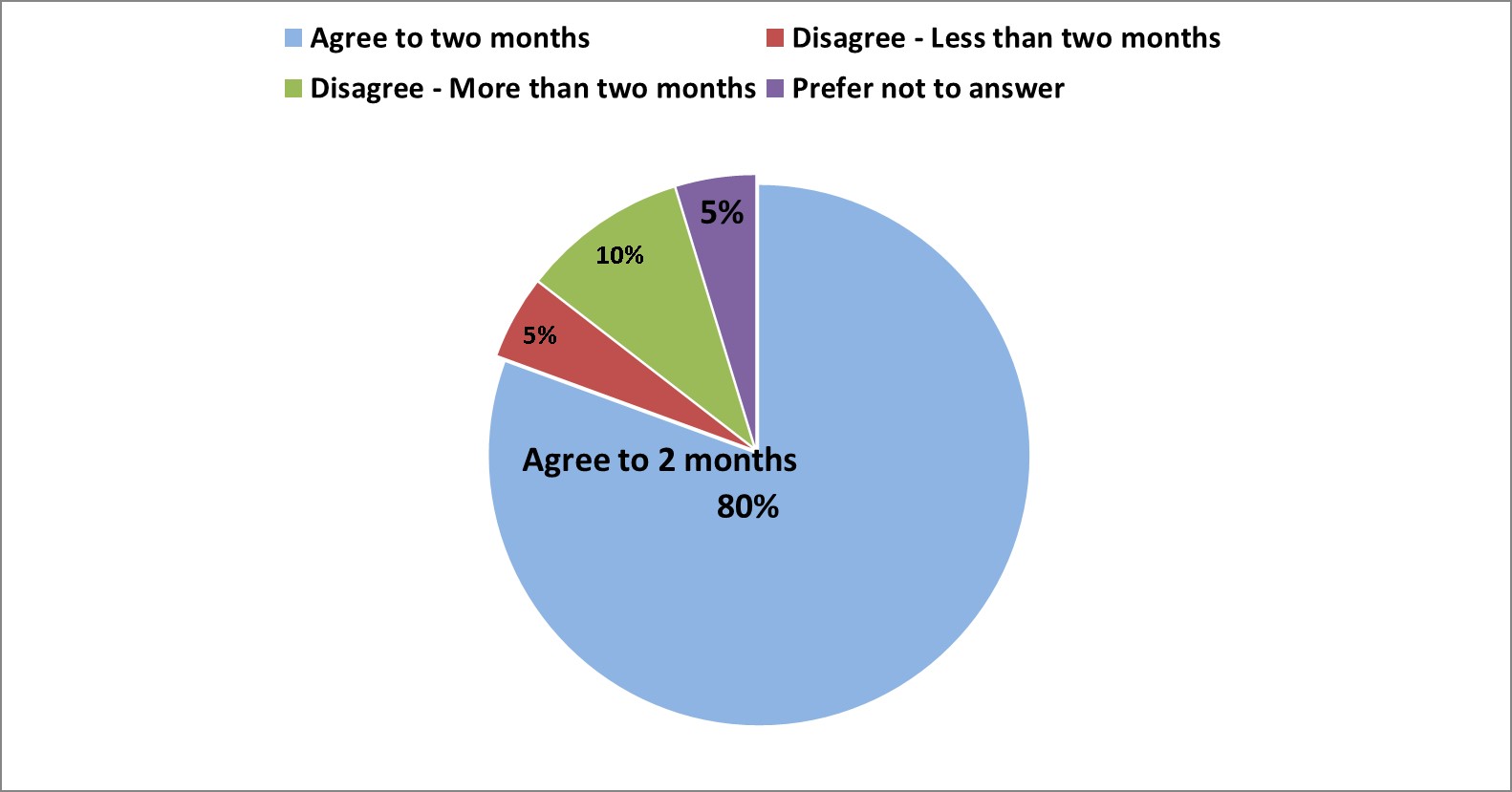
Text description
| Response | Number of responses | % |
|---|---|---|
| Agree to two months | 872 | 80% |
| Disagree - Less than two months | 53 | 15% |
| Disagree - More than two months | 106 | |
| Prefer not to answer | 51 | 5% |
| Grand Total | 1029 | 100% |
Should an investigation be completed by a investigator, their report will include recommendations that outline the development and implementation of effective controls to eliminate or minimize harassment and violence in the workplace.
78% of respondents agreed with the statement: “When the investigator’s report is submitted, the amended regulations will require the employer to implement all appropriate recommendations, as determined by the workplace committee, as soon as possible but no later than six months.”
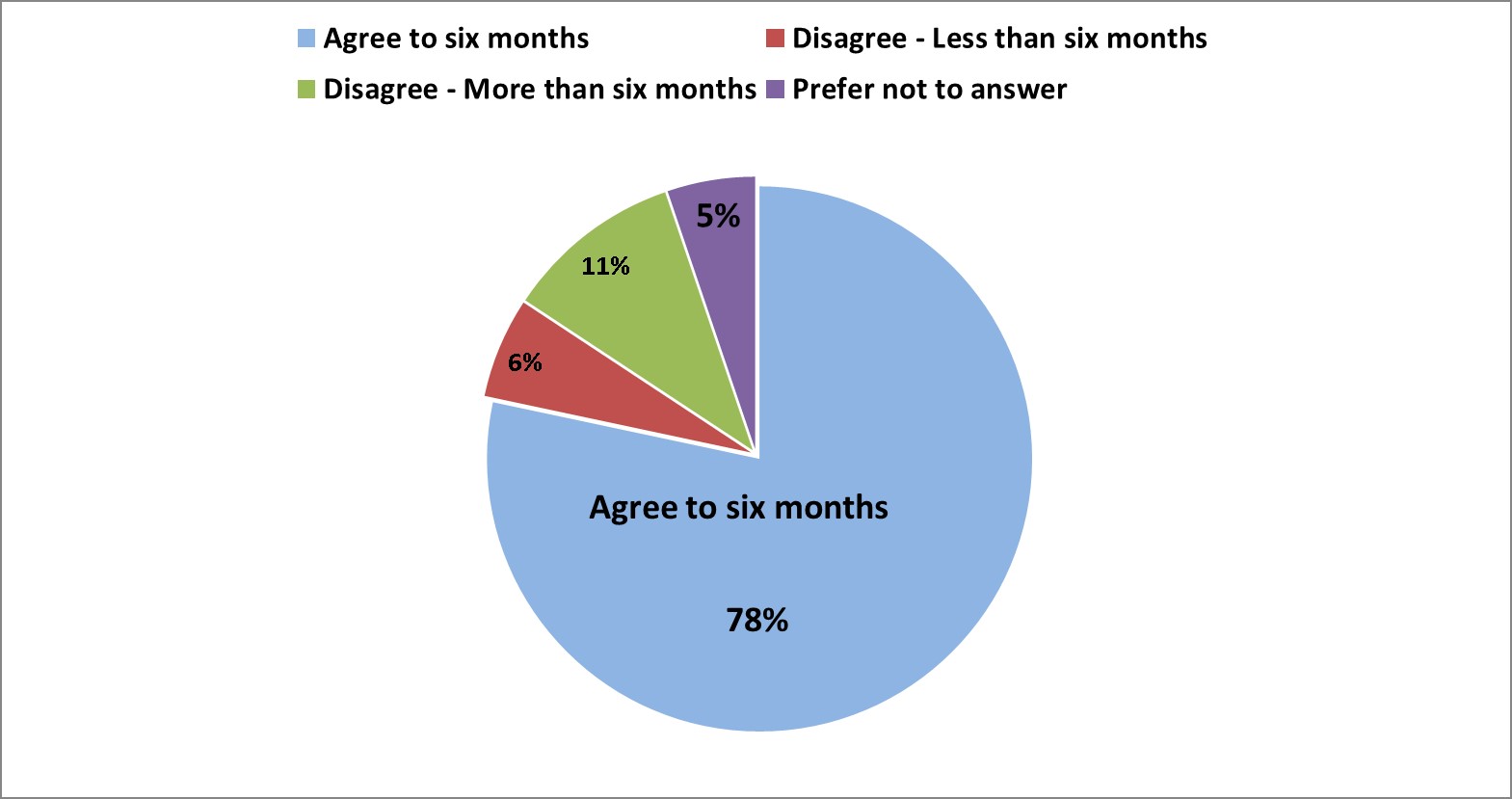
Text description
| Response | Number of respondants | % |
|---|---|---|
| Agree to six months | 857 | 78% |
| Disagree - Less than six months | 65 | 17% |
| Disagree - More than six months | 115 | |
| Prefer not to answer | 57 | 5% |
| Grand Total | 1029 | 100% |
Training
The regulations will require federally regulated employers to provide training to everyone in the workplace, including the employer, employee representatives, supervisors and managers.
We proposed various elements that training would be required to cover. Below is the percentage of respondents that thought a particular element should be covered in training.
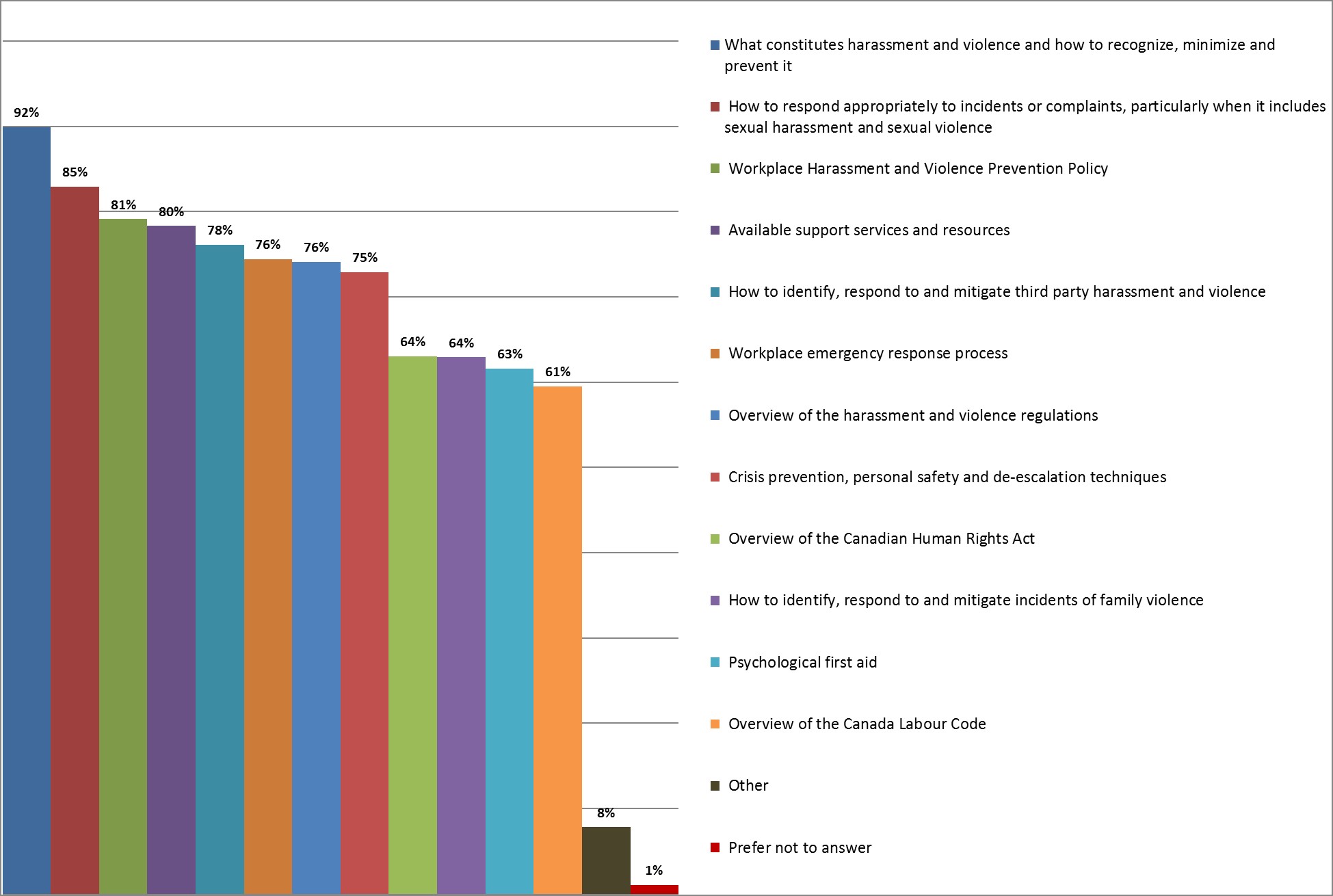
Text description
| Response | Number of respondants | % |
|---|---|---|
| What constitutes harassment and violence and how to recognize, minimize and prevent it | 899 | 92% |
| How to respond appropriately to incidents or complaints, particularly when it includes sexual harassment and sexual violence |
829 | 85% |
| Workplace Harassment and Violence Prevention Policy | 791 | 81% |
| Available support services and resources | 783 | 80% |
| How to identify, respond to and mitigate third party harassment and violence | 761 | 78% |
| Workplace emergency response process | 744 | 76% |
| Overview of the harassment and violence regulations | 741 | 76% |
| Crisis prevention, personal safety and de-escalation techniques | 729 | 75% |
| Overview of the Canadian Human Rights Act | 630 | 64% |
| How to identify, respond to and mitigate incidents of family violence | 629 | 64% |
| Psychological first aid | 616 | 63% |
| Overview of the Canada Labour Code | 595 | 61% |
| Other | 78 | 8% |
| Prefer not to answer | 10 | 1% |
| Grand Total | 8835 | 978 |
In the survey, we stated that training on workplace violence prevention currently must occur every three years. We then asked: “Based on your current federally regulated work environment, what is an appropriate frequency for training?”
In response, 54% of respondents thought harassment and violence prevention training should occur annually.
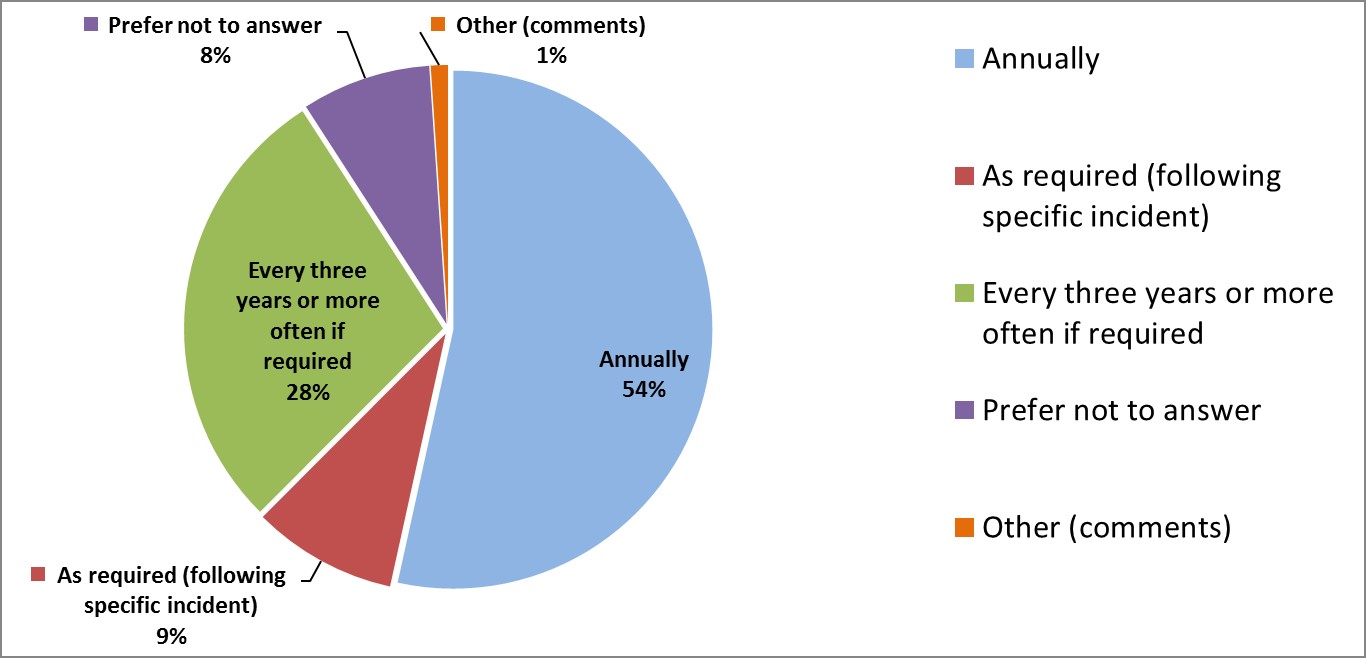
Text description
| Response | Number of responses |
|---|---|
| Annually | 532 |
| As required (following specific incident) | 76 |
| Every three years | 235 |
| Prefer not to answer | 83 |
| Other | 103 |
| Grand Total | 1029 |
Competent person
The amended regulations will stipulate the elements that need to be included in a investigator’s report as a result of an investigation of workplace harassment and violence.
The following chart shows respondents’ support for whether each specific element should be mandatory in a Competent person’s report.
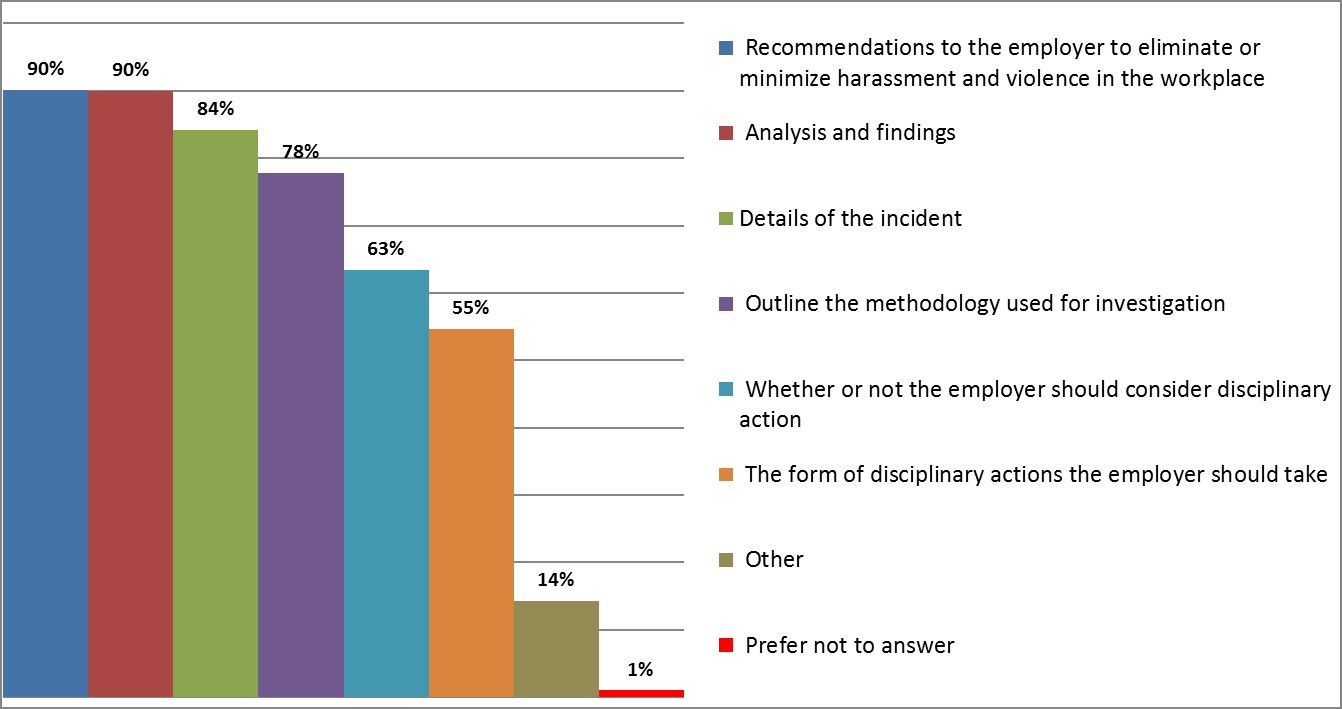
Text description
| Response | Number of respondants | % |
|---|---|---|
| Recommendations to the employer to eliminate or minimize harassment and violence in the workplace |
901 | 90% |
| Analysis and findings | 900 | 90% |
| Details of the incident | 842 | 84% |
| Outline the methodology used for investigation | 778 | 78% |
| Whether or not the employer should consider disciplinary action | 634 | 63% |
| The form of disciplinary actions the employer should take | 546 | 55% |
| Other | 143 | 14% |
| Prefer not to answer | 10 | 1% |
| Grand Total | 4754 | 100% |
Support
The amended regulations will emphasize support to all parties involved in an incident of harassment and violence in the workplace (complainant, respondent, and witnesses). We asked a series of questions of which support options should be made available and who should provide them?
87% of respondents agreed that physical support to the complainant should be made available, including medical care if necessary, and 41% of respondents indicated that the employer was in the best position to provide the necessary physical support.
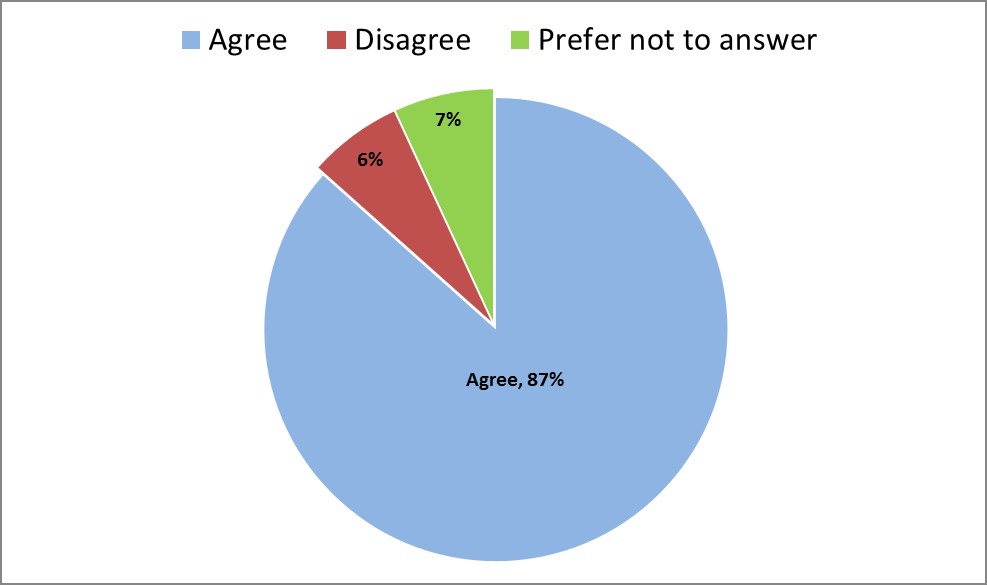
Text description
| Response | Number of responses | % |
|---|---|---|
| Agree | 891 | 87% |
| Disagree | 67 | 7% |
| Prefer not to answer | 71 | 7% |
| Grand Total | 1029 | 100% |
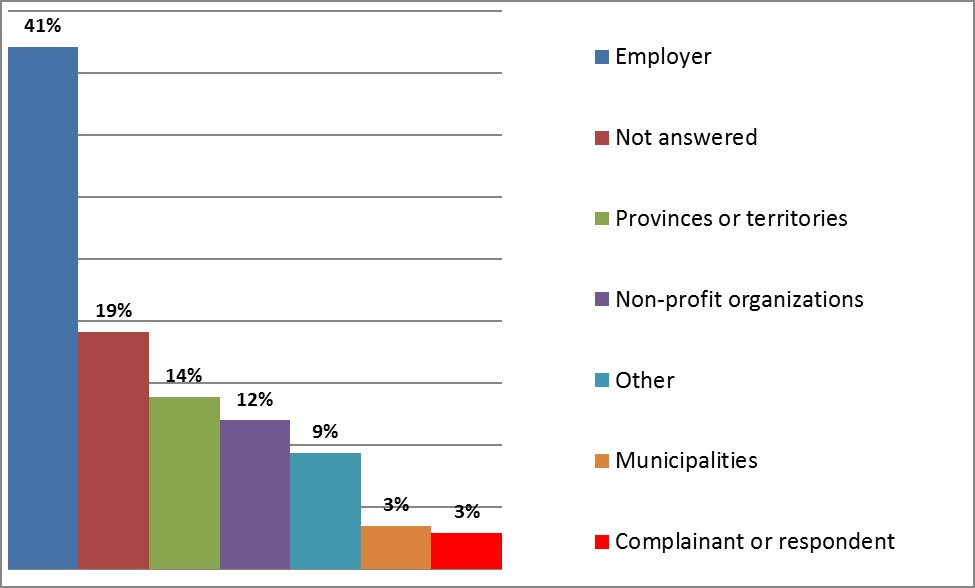
Text description
| Response | Number of responses | % |
|---|---|---|
| Employer | 421 | 41% |
| Not answered | 191 | 19% |
| Provinces or territories | 139 | 14% |
| Non-profit organizations | 120 | 12% |
| Other | 94 | 9% |
| Municipalities | 35 | 3% |
| Complainant or respondent | 29 | 3% |
| Grand Total | 1029 | 100% |
In relation to psychological support, 85% of respondents agree that a list of local psychological support resources should be made available to all parties, with 63% indicating that the employer make this service available.
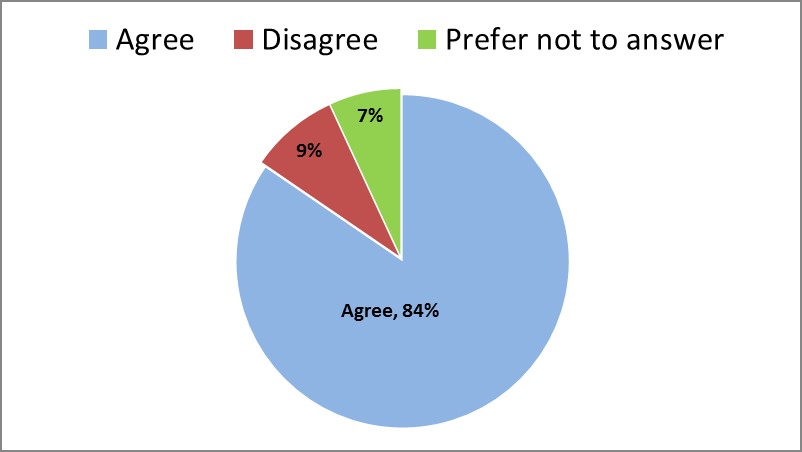
Text description
| Response | Number of responses | % |
|---|---|---|
| Agree | 870 | 85% |
| Disagree | 88 | 9% |
| Prefer not to answer | 71 | 7% |
| Grand Total | 1029 | 100% |
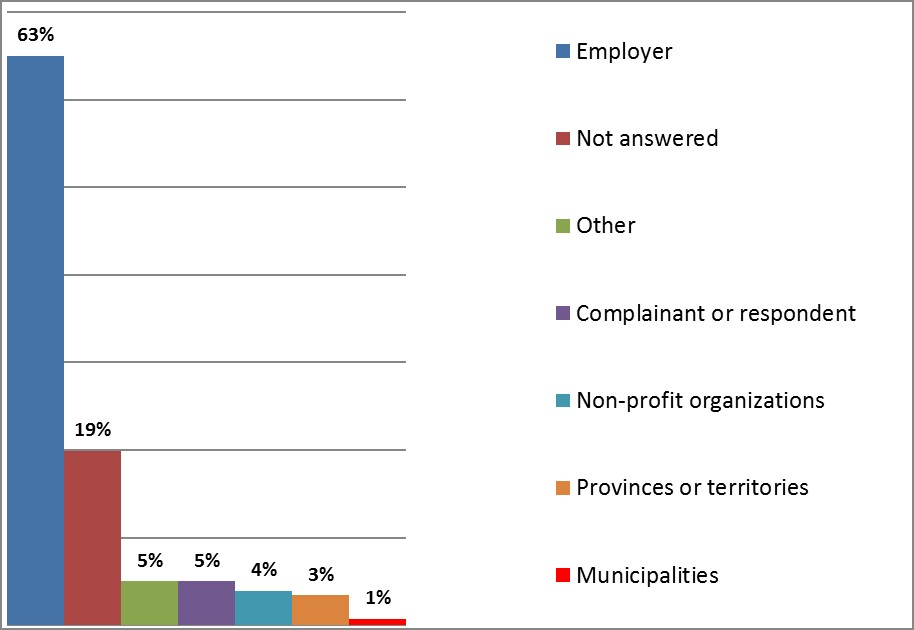
Text description
| Response | Number of responses | % |
|---|---|---|
| Employer | 650 | 63% |
| Not answered | 199 | 19% |
| Other | 50 | 5% |
| Complainant or respondent | 50 | 5% |
| Non-profit organizations | 39 | 4% |
| Provinces or territories | 34 | 3% |
| Municipalities | 7 | 1% |
| Grand Total | 1029 | 100% |
80% of respondents agree adjustments to the workplace environment to reduce the potential for continued harassment and violence should be made available to all parties.
42% of the respondents felt that the employer should provide the required accommodation.
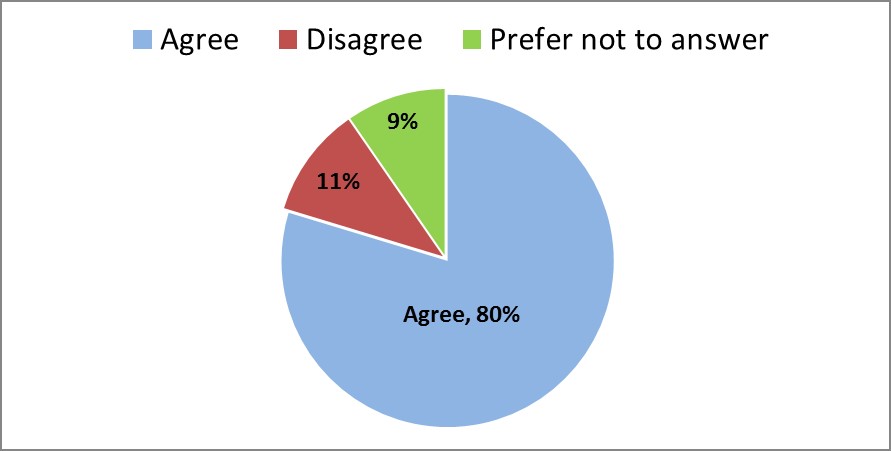
Text description
| Response | Number of responses |
|---|---|
| Agree | 820 |
| Disagree | 110 |
| Prefer not to answer | 99 |
| Grand Total | 1029 |
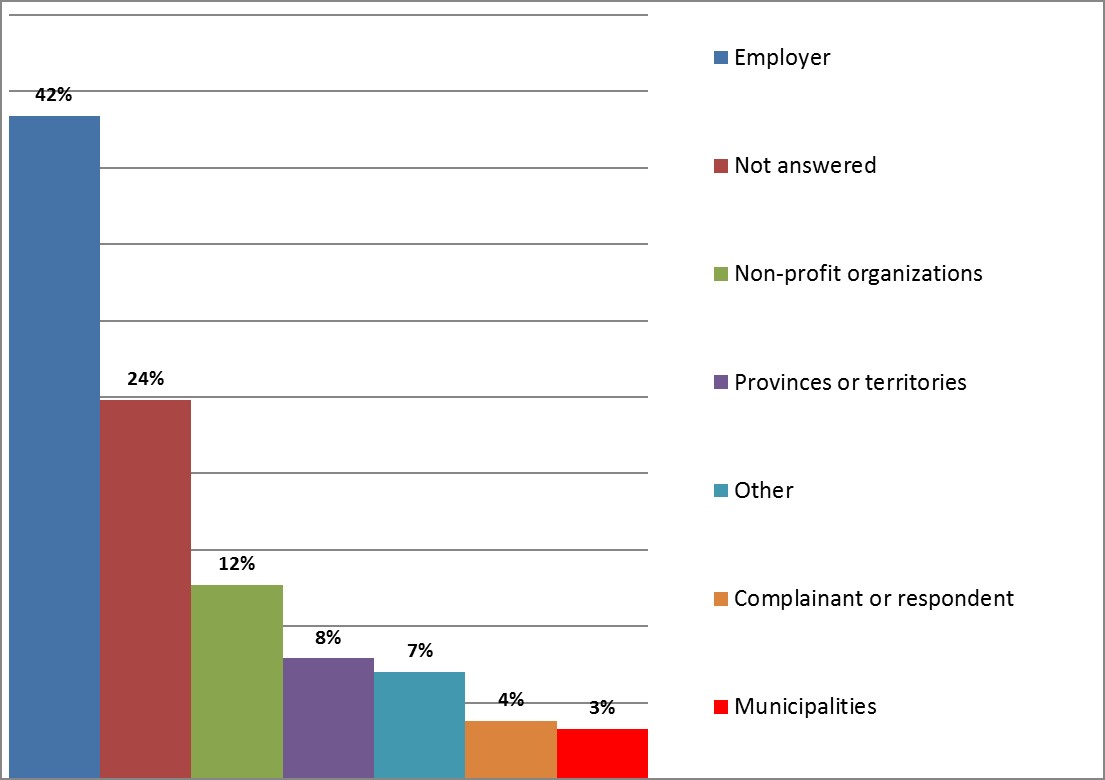
Text description
| Response | Number of responses | % |
|---|---|---|
| Employer | 434 | 42% |
| Not answered | 248 | 24% |
| Non-profit organizations | 127 | 12% |
| Provinces or territories | 79 | 8% |
| Other | 70 | 7% |
| Complainant or respondent | 38 | 4% |
| Municipalities | 33 | 3% |
| Grand Total | 1029 | 100% |
Regarding social support, 83% of respondents agree that social support for the complainant and witnesses, from peers to supervisors (if consent from the parties is obtained), should be made available, with 40% indicating that the employer make these services available.
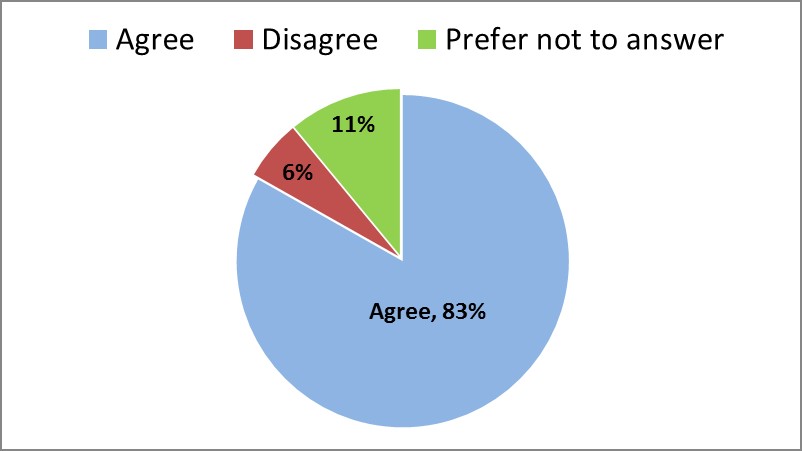
Text description
| Response | Number of responses |
|---|---|
| Agree | 856 |
| Disagree | 60 |
| Prefer not to answer | 113 |
| Grand Total | 1029 |
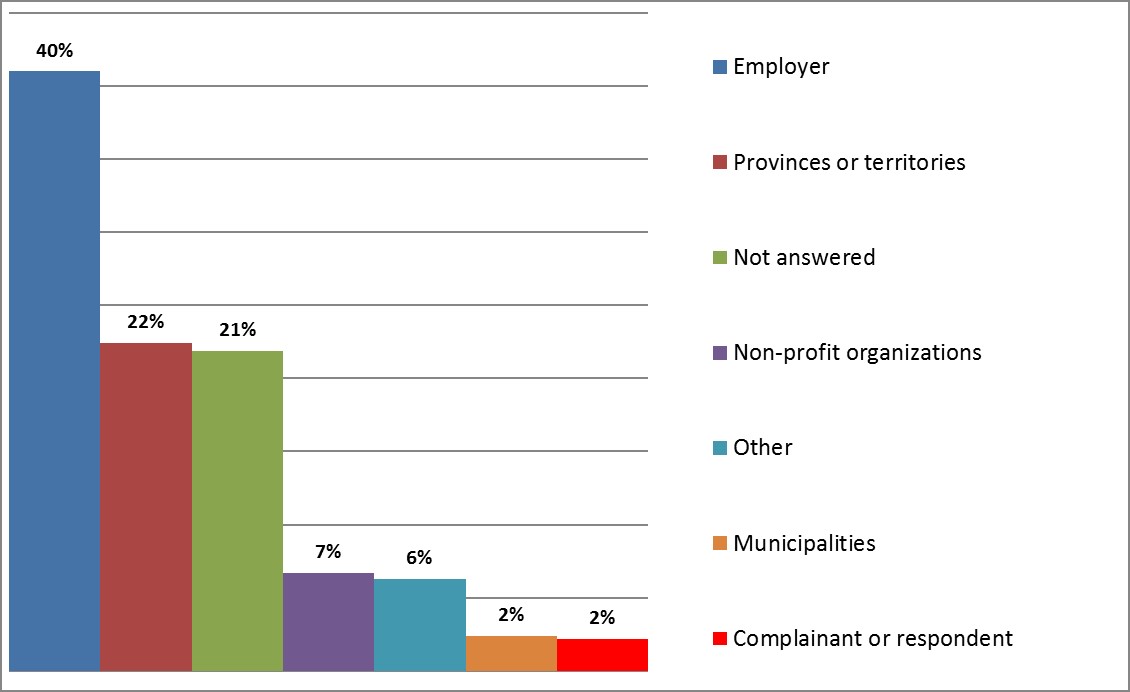
Text description
| Response | Number of responses | % |
|---|---|---|
| Employer | 410 | 40% |
| Provinces or territories | 224 | 22% |
| Not answered | 219 | 21% |
| Non-profit organizations | 67 | 7% |
| Other | 63 | 6% |
| Municipalities | 24 | 2% |
| Complainant or respondent | 22 | 2% |
| Grand Total | 1029 | 100% |
Policies and reporting
To ensure that federally regulated workplaces are equipped with clear and meaningful workplace harassment and violence prevention policies, the regulations will set out required elements that the policies will need to address.
We proposed various elements for possible inclusion in the prevention policies. For each element, the chart below shows the percentage of respondents who thought an element should be mandatory.
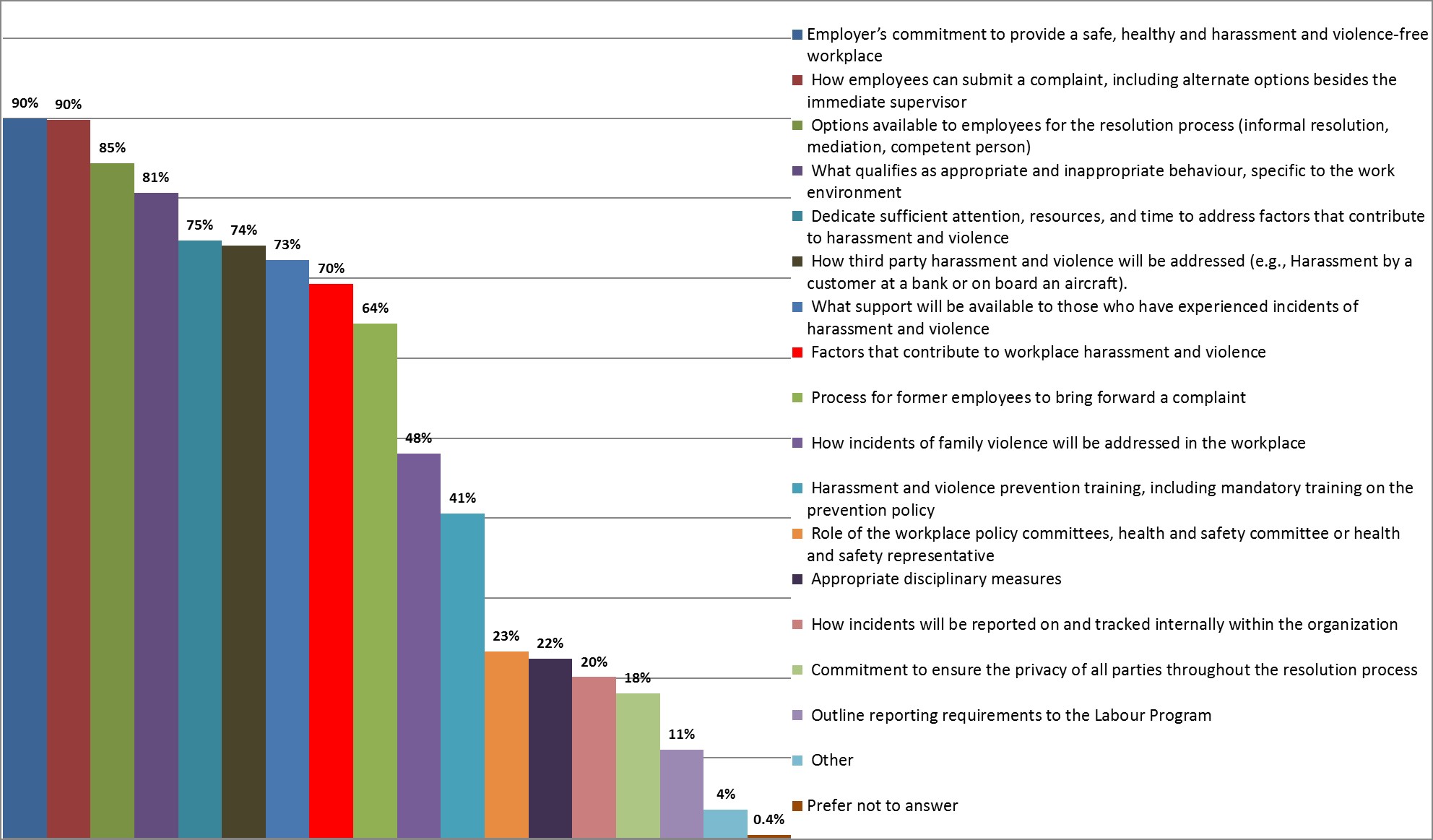
Text description
| Response | Number of respondents | % |
|---|---|---|
| Employer’s commitment to provide a safe, healthy and harassment and violence-free workplace | 900 | 90% |
| How employees can submit a complaint, including alternate options besides the immediate supervisor | 898 | 90% |
| Options available to employees for the resolution process (informal resolution, mediation, investigator) | 844 | 85% |
| What qualifies as appropriate and inappropriate behaviour, specific to the work environment | 807 | 81% |
| Dedicate sufficient attention, resources, and time to address factors that contribute to harassment and violence | 747 | 75% |
| How third party harassment and violence will be addressed (e.g., Harassment by a customer at a bank or on board an aircraft). | 741 | 74% |
| What support will be available to those who have experienced incidents of harassment and violence | 723 | 73% |
| Factors that contribute to workplace harassment and violence | 693 | 70% |
| Process for former employees to bring forward a complaint | 643 | 64% |
| How incidents of family violence will be addressed in the workplace | 481 | 48% |
| Harassment and violence prevention training, including mandatory training on the prevention policy | 406 | 41% |
| Role of the workplace policy committees, health and safety committee or health and safety representative | 233 | 23% |
| Appropriate disciplinary measures | 224 | 22% |
| How incidents will be reported on and tracked internally within the organization | 201 | 20% |
| Commitment to ensure the privacy of all parties throughout the resolution process | 181 | 18% |
| Outline reporting requirements to the Labour Program | 110 | 11% |
| Other | 35 | 4% |
| Prefer not to answer | 4 | 0.4% |
| Grand Total | 8871 | 997 |
We asked an open ended question about how the regulations on workplace harassment and violence prevention should address persons granted access to a workplace, such as job interviewees, external contractors, and volunteers.
The majority of respondents thought that this issue should be explicitly addressed in the employer’s policy.
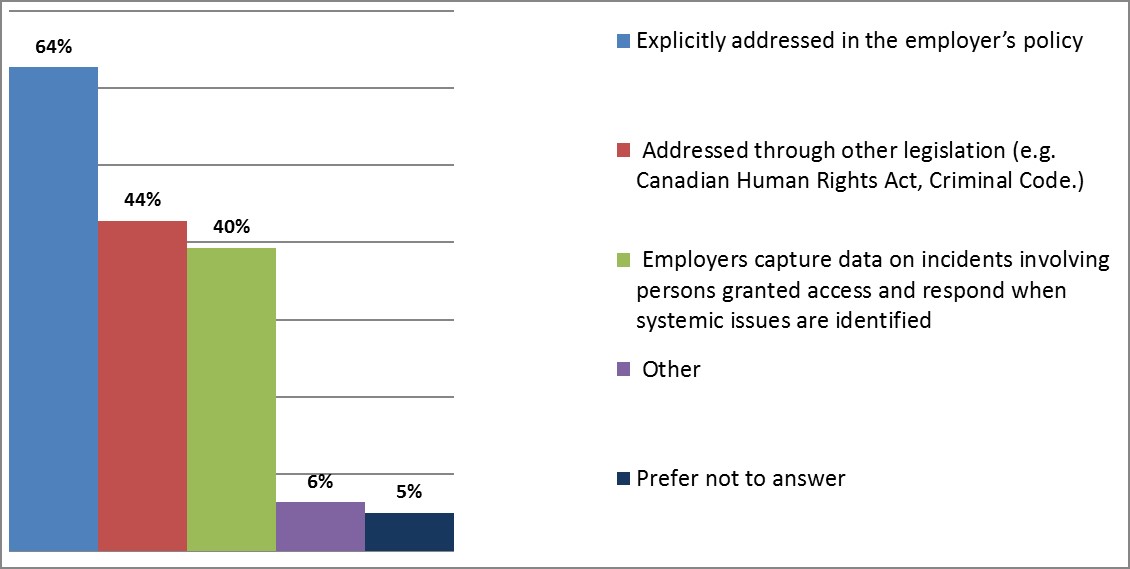
Text description
| Response | Number of respondents | % |
|---|---|---|
| Explicitly addressed in the employer’s policy | 627 | 64% |
| Addressed through other legislation (e.g. Canadian Human Rights Act, Criminal Code.) | 428 | 44% |
| Employers capture data on incidents involving persons granted access and respond when systemic issues are identified | 393 | 40% |
| Other | 63 | 6% |
| Prefer not to answer | 49 | 5% |
| Grand Total | 1560 | 97300% |
Family violence
The effects of family violence are felt not only at home but also in the workplace. As a result, employers will be required to outline how they will respond to situations in the workplace where there is a concern that family violence may make its way into the workplace.
Regarding which provisions should be captured in the employer`s prevention policy, the chart below describes respondents’ support for particular provisions by percentage.
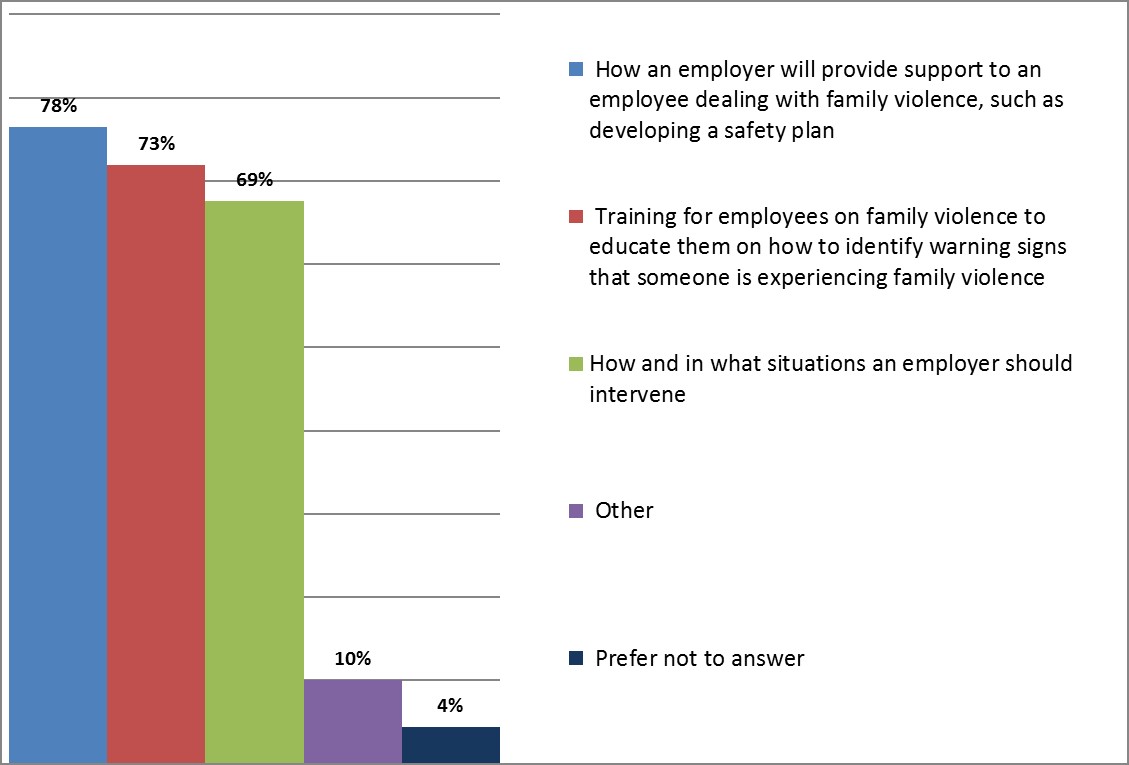
Text description
| Response | Number of respondents | % |
|---|---|---|
| How an employer will provide support to an employee dealing with family violence, such as developing a safety plan | 765 | 78% |
| Training for employees on family violence to educate them on how to identify warning signs that someone is experiencing family violence | 719 | 73% |
| How and in what situations an employer should intervene | 676 | 69% |
| Other | 101 | 10% |
| Prefer not to answer | 44 | 4% |
| Grand Total | 2305 | 980 |
Page details
- Date modified: